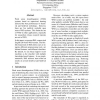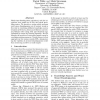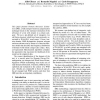37 search results - page 1 / 8 » It Makes Sense: A Wide-Coverage Word Sense Disambiguation Sy... |
ACL
2010
13 years 2 months ago
2010
Word sense disambiguation (WSD) systems based on supervised learning achieved the best performance in SensEval and SemEval workshops. However, there are few publicly available ope...
ACL
1998
13 years 5 months ago
1998
Word sense disambiguation algorithms, with few exceptions, have made use of only one lexical knowledge source. We describe a system which t)erforms word sense disambiguation on al...
EMNLP
2004
13 years 5 months ago
2004
This paper presents Domain Relevance Estimation (DRE), a fully unsupervised text categorization technique based on the statistical estimation of the relevance of a text with respe...
CORR
2004
Springer
13 years 4 months ago
2004
Springer
This paper describes the National Research Council (NRC) Word Sense Disambiguation (WSD) system, as applied to the English Lexical Sample (ELS) task in Senseval-3. The NRC system ...
EACL
2006
ACL Anthology
13 years 5 months ago
2006
ACL Anthology
The degree of dominance of a sense of a word is the proportion of occurrences of that sense in text. We propose four new methods to accurately determine word sense dominance using...



